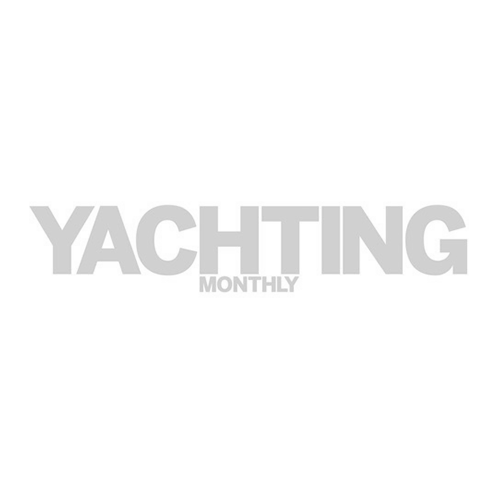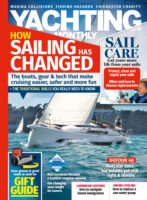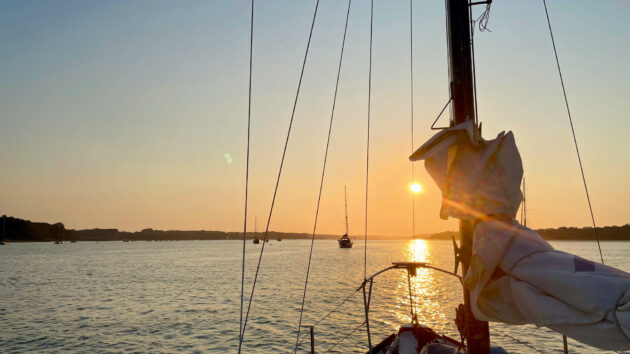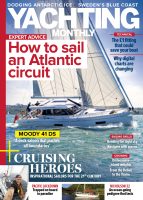To depart or not to depart? That is the question. Is it safer to stay, or suffer the wind and weather of a rough North Sea?
With apologies to Shakespeare – our dilemma could hardly be compared to Hamlet’s, but it was real. Once again, though for the first time since Brexit, we were heading for the Netherlands from Suffolk Yacht Harbour.
Months in the planning, we were itching to cast off, but the reality was a nagging northeast Force 6. If we left, that would be a horrible first 6-8 hours.
Like Hamlet, we dithered and delayed, and eventually set off the next afternoon, still northeast, but now Force 4 – it was manageable.
Jenny, my crew, is an expert navigator and passage planner, very adept with modern technology – the perfect foil for my technological ineptitude. In her 20 years of sailing she has acquired RYA qualifications and done overseas delivery trips with Professional Yacht Deliveries. We share the helm, half hour on, half hour off. Like me, she enjoys the sailing rather than just being on a boat. Excellent crew and after 10 years she still comes back for more!
Those of you with 10m-plus yachts and 20hp diesels will be wondering why I’m such a wimp. My Nova 27 is 50 years old with a single cylinder SABB 10hp. It is solid and reliable, but noisy and slow, so I sail as soon as is practical.

Maisie sailing on the River Orwell. Photo: John Kingsnorth
Sailing to the southern Netherlands from Harwich, the first major obstacle is the Gabbard wind farm. Due to sunk shipping, small boats are advised to go north of Gabbard, which means heading northeast for 30 miles. For an old 27-footer, you need the help of the tide, in this case 2 knots, but you then have wind-over-tide – uncomfortable!
In the event, there was enough east in the wind for us to romp up the Shipway to N Shipwash buoy at 7 knots speed over ground. In the dark, we motored round the top of Gabbard, the windfarm lit up like a floating city, all winking lights at different levels. Adding to the illuminations was a surprising amount of shipping, especially ferries.
With just enough north in the wind, we were able to lay a course southeast across the North Hinder TSS and into the Borssele Pass. Unlike Thames Estuary wind farms, which are laid out in regular straight rows, Borssele is more random. Initially, the Pass was not obvious, but GPS established that we were in the right passage.
By now, it was early afternoon with everything sparkling and we cheered the northeasterly as it sped us east at over 5 knots. The ebbing tide helped across the Steenbank area and we had a glorious evening sail as we sedately creamed up the Roompot channel.

A spinnaker run in the Oosterschelde. Photo: John Kingsnorth
A calm sea, land visible on the starboard bow, and the sun a golden orb behind us. Roompot lock was straightforward; we motored over to the marina, tied up and flopped. Tired but satisfied with a successful crossing.
Bewildering brexit
Pre Brexit, sailors entered the Netherlands without bureaucracy. This time, it was very confusing.
I struggled and swore my way through pre-trip online documents. It appears mandatory (really?) to have: boat registration, insurances, GHIC, passport, radio licence, ICC (incl CEVNI) and diesel receipts. And then more fun with online immigration forms for both countries with numerous links and references… help! The words ‘need’ and ‘must’ occur alarmingly frequently.
So, on the first morning in Roompot Marina, we headed for the office with every document imaginable. The marina office staff spoke excellent English and phoned Immigration in Vlissingen.

: The Zeeland Bridge opens to let tall masts through. Photo: John Kingsnorth
They arrived in 20 minutes in a van kitted out as a mobile immigration office. Though uniformed and bristling with weaponry, they were pleasant and helpful, their only interest being to stamp the passports. They were not remotely bothered with all the other stuff, and nor was anyone else throughout the trip. Hmmm?
I was beginning to suspect that rubric and reality were not quite in sync.
The Oosterschelde is a large inland sea created by the Dutch Delta Plan, crossed by a motorway on the Zeeland Bridge with spans 12m above high-tide level. I think the tip of Maisie’s aerial atop the mast is 12.5m. As the tide had been ebbing for two hours, we were modestly confident of getting through.
As we approached our chosen span, a gauge at the base showed 13.5m. It is always a deceptive and alarming experience approaching a low bridge. It seems impossible that the mast and all will go under, but then… phew! I have no idea how close we were, but it looked very close.

Skipper John Kingsnorth enjoying the helm in ideal conditions. Photo: John Kingsnorth
Navin’s excellent Cruising Guide to the Netherlands is never far from my armchair at home or in the cockpit aboard Maisie. On previous occasions we had done the Veerse Meer and this time wanted to explore the Grevelingenmeer, recommended by Navin.
He also rates Goes, off the Oosterschelde, which was easier to get to with sea conditions as they were. After a brief discussion with crew Jenny, we changed direction and charged off southwest at 5 knots, heading for Goes.
A word about pronunciation – imagine clearing your throat and going ‘hoosh’ – you just about have ‘Goes’. I tried speaking Dutch once and the man looked at me blankly and asked me to speak English. Most Dutch speak good English and are happy to do so.

The Zeeland Bridge over the Oosterschelde. Photo: John Kingsnorth
Many Dutch towns are accessed by locks and canals with clear traffic lights and a VHF channel. So too with Sas van Goes, and, apart from wet and slimy walls, the procedure was straightforward. We exited into a beautiful stretch of tree-lined canal. To my shame, I was so taken with the vista that I nearly ran over a swimmer who, unperturbed, continued his dogged way towards the lock pontoon.
A wake-up call to be vigilant. We negotiated many more swimmers, all in good humour and, seeing our ensign, hailed us like long-lost travellers. As we rounded a bend, thinking of phoning for a bridge opening ahead, a huge barge filled the canal, coming straight for us.
No pictures with this one I’m afraid as it was: (a) get out of the way, (b) go aground, (c) rev engines to stay afloat but miss barge and (d) grab a fender. Yes, we were that close! Then, just as suddenly, all was quiet with the canal clear, the bridge open and on we pottered with heartbeats back to normal!

Motoring along the Goes canal, avoiding some swimmers. Photo: John Kingsnorth
Exploring and stocking up
In Navin’s Cruising Guide to the Netherlands there is a picture of a little marina (reminiscent of the prettier parts of the Norfolk Broads) looking quieter and more attractive than the town centre berths.
What a great spot! The helpful, friendly and chatty Havenmeister gave us our berth and proudly showed us our personal loo in the tower.

View of Haarlem, a typical Dutch town, as seen on another trip. Photo: John Kingsnorth
After photos and ablutions we had a brief walk into the centre of this typical and charming Dutch town. In the square, one restaurant was doing a particularly bustling trade and its ‘Menu of the Month’ was extremely good value for three delicious courses and lots of beer – a necessity in the heat. An after-dinner saunter brought us to the main church and some eye-catching murals, with one highlighting Ukrainian issues which I found particularly moving.
The next morning we replenished supplies at a nearby supermarket, with prices comparable to the UK. We returned to Maisie, as happy sailors and crammed cheeses, yoghurts, currant buns, apples, grapes, fruit juice and sparkling water into every onboard crevice we could find.

The WV De Werf Marina at Goes. Photo: John Kingsnorth
Before heading back for the Oosterschelde we compared notes on our Dutch experiences:
- Brexit: Universal sympathy from the Dutch who were bemused and puzzled by it. Officials also found it frustrating, as it has given them a lot more work.
- Navigation: We were amazed that locks and canals were staffed, in good order and free. Our €1 tourist tax seemed very good value. There is a free publication available in every marina called ‘De Havengids’ (Zuid-Nederland). It is in Dutch but the pictures, maps and symbols are easy to figure out and provide very useful additional information for sailors.
- Sea defences: In East Anglia we are concerned about coastal erosion. The Dutch have tackled it head on with miles and miles of dykes building in recreational facilities, so the top of the banks have cycle tracks, usually tarmac, and there are locks, canals and marinas everywhere.
Back in the Oosterschelde the northeast wind picked up and the ebb tide remained strong, making the Grevelingenmeer too much of a slog. Jenny had fond memories of Zierikzee so we happily changed plans and went there instead, having first visited it seven years before. It is another historic and picturesque town but not for this particular yarn.
Later in the week back in Roompot, we enjoyed an evening beach walk, swim and restaurant ‘meal-for-two’ served on a plank! In the morning Dutch Immigration came and gave us our exit stamp and we departed.

Historic houses at Goes marina create an attractive backdrop. Photo: John Kingsnorth
Heading home
Our trip across the North Sea involved 54-mile starboard tack at 5 knots in bright sunshine. In his play Rosencrantz and Guildenstern are Dead, Tom Stoppard has the two men, mid-sea, speculating on the whereabouts of England. ‘Just a conspiracy of cartographers, then?’ says Guildenstern. It feels that way until the cranes of Felixstowe loom out of the haze.
On entering the Orwell I rang Border Force and was told I could take the Q flag down. There was no need to report in as I had filled in ‘the form’ before departure. I just smiled and said thank you.
I am already planning a return trip for next year, when I’m determined to get to the Grevelingenmeer or just back to any part of this wonderful sailing playground – which is only 25 hours away.
I cannot recommend it highly enough. For the moment, I have the happy memories of this trip to reminisce over. Thank you, crew, for tolerating my foibles. Well done Maisie for keeping us safe.
Enjoyed reading this?
A subscription to Yachting Monthly magazine costs around 40% less than the cover price, so you can save money compared to buying single issues.
Print and digital editions are available through Magazines Direct – where you can also find the latest deals.
YM is packed with information to help you get the most from your time on the water.
-
-
- Take your seamanship to the next level with tips, advice and skills from our experts
- Impartial in-depth reviews of the latest yachts and equipment
- Cruising guides to help you reach those dream destinations
-
Follow us on Facebook, Twitter and Instagram.





